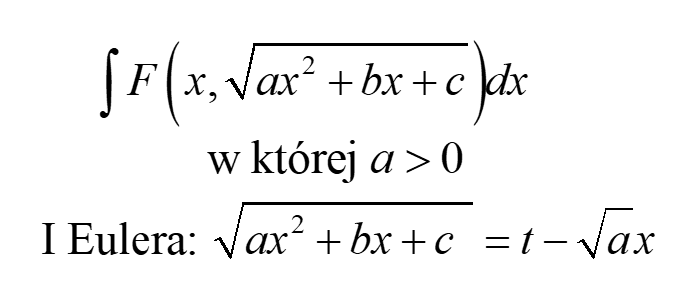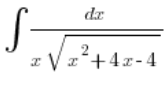
Euler Substitutions of the First Kind
Krystian Karczyński
Founder and General Manager of eTrapez.
Graduate of Mathematics at Poznan University of Technology. Mathematics tutor with many years of experience. Creator of the first eTrapez Courses, which have gained immense popularity among students nationwide.
He lives in Szczecin, Poland. He enjoys walks in the woods, beaches and kayaking.
Euler Substitutions – Who Needs Them?
Euler substitutions in indefinite integrals are the next topic introduced after rational integrals, trigonometric integrals, and integrals with roots (or according to some classifications: “irrational integrals”). This means that most students won’t have the pleasure of encountering them. I also didn’t include them in my Course on Indefinite Integrals.
However, there remains a quite significant group of students in mathematical disciplines, or those really, really “strong” in mathematics, who have to tackle Euler substitutions, and I invite those (as well as the curious ones). I will discuss all three types of Euler substitutions (in this post, I’ll tackle the first kind) and make one example for each.
Let’s go.
What Kind of Integrals Do We Solve with Euler Substitutions?
Euler substitutions help us crack integrals of the type:

…so, any random relations between ![]()
![]()
![]()
![]()
![]()
![]()
![]()
![]()
![]()
![]()
![]()
![]()
![]()
![]()
![]()
![]()
We use Euler substitutions for integrals that can’t be solved more simply, of course. For example, the integral:
![]()
![]()
![]()
![]()
![]()
![]()
![]()
![]()
![]()
![]()
![]()
![]()
![]()
![]()
![]()
![]()
![]()
![]()
![]()
![]()
But let’s consider the integral:



We see the situation is more serious, and our previously known substitutions ![]()
![]()
![]()
![]()
![]()
![]()
![]()
![]()
![]()
![]()
![]()
![]()
![]()
![]()
We need a new weapon.
Euler Substitutions – Type I
Given an integral:





where ![]() ,
,
we apply the substitution:
![]()
![]()
Raise both sides to the square, the ![]()
![]()


expressed with relations of t, and substitute into the original integral:





and we end up with an integral in terms of t (if we still have any x’s left, we’ve made a mistake), and it is a rational integral.
Note
It’s also worth adding that in practice, many students are only introduced to Euler’s substitutions of Type I, and only for integrals of the type:





, i.e., those where it appears as if ![]()
![]()
Let’s follow the Euler substitutions of the first kind in action, using this example:
Example 1



We determine that this is an integral where the relationship between ![]()
![]()
![]()
![]()
![]()
![]()
![]()
![]()
![]()
![]()
![]()
![]()
![]()
![]()
![]()
![]()
![]() (
(![]()
![]()
![]()
![]()
![]()
![]()
So, we will be using the Euler substitution of the first kind.
I substitute:
![]()
![]()
which simply means:
![]()
![]()
![]()
![]()
I raise both sides to the square:
![]()
![]()
The terms with ![]()
![]()
![]()
![]()
![]()
![]()
And now, we need to determine ![]()
![]()
![]()
![]()
![]()
![]()
![]()
![]()
![]()
![]()
![]()
![]()
![]()
![]()
![]()
![]()
![]()
![]()
![]()
![]()
Let’s start with ![]()
![]()
![]()
![]()
![]()
![]()
![]()
![]()
![]()
![]()
![]()
![]()
![]()


We have ![]()
![]()
![]()
![]()
![]()
![]()
![]()
![]()
![]()
![]()
![]()
![]()
![]()
![]()
![]()
![]()
![]()
![]()
![]()
We go back to our first substitution, which was:
![]()
![]()
![]()
![]()
Now that we know ![]()
![]()
![]()
![]()
![]()
![]()
![]()
![]()
![]()
![]()


which means:


So, we have ![]()
![]()
![]()
![]()
![]()
Finally, ![]()
![]()
![]()
![]()
![]()
![]()
![]()
![]()
![]()
![]()
![]()
![]()
![]()
![]()


And that’s how we determine ![]()
![]()
![]()
![]()


We substitute all of this into the original integral:


At first glance, this looks like a tedious, yet familiar rational integral (decomposition into partial fractions, the second factor in the denominator can be further decomposed). Usually, that’s the case, but in this specific example, we’ll be a bit lucky and avoid going through 3 pages of A4 calculations:


How to return to the substitution? Initially, we had:
![]()
![]()
![]()
![]()
From which, of course:
![]()
![]()
Thus, our result is:


To be continued. (we still have two more types of Euler substitutions to cover, what if the coefficient ![]()
![]()
![]()
Are you looking for college or high school math tutoring? Or maybe you need a course that will prepare you for the final exam?
We are "eTrapez" team. We teach mathematics in a clear, simple and very precise way - we will reach even the most knowledge-resistant students.
We have created video courses translated in an easy, understandable language, which can be downloaded to your computer, tablet or phone. You turn on the video, watch and listen, just like during private lessons. At any time of the day or night.




